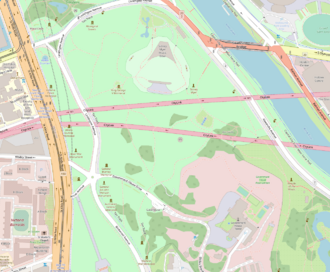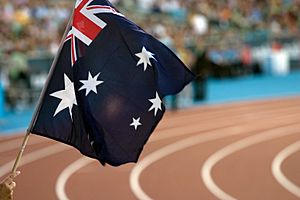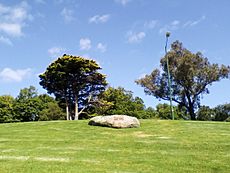Camp Sovereignty facts for kids

King's Domain Victoria
|
|
| Date | 12 March 2006 |
|---|---|
| Location | King's Domain, Victoria |
| Type | Demonstration |
| Theme | Australian Indigenous rights |
| Organized by | Marg Thorpe, Robbie Thorpe, Gary Foley, Robert Corowa |
Camp Sovereignty is the name given to an Indigenous Australian protest movement established to publicise the "Black GST" political group. The "GST" reflects the group's aims of ending genocide, acknowledging sovereignty and securing a peace treaty.
On 12 March 2006 a camp was established and a ceremonial fire was lit in Kings Domain, a public park in Melbourne to symbolise the continuing presence of Indigenous culture in Australia. This camp was also used to protest against the Commonwealth Games, referred to by the protesters as the "Stolenwealth Games" in reference to the group's negative perceptions of the Commonwealth and their historical actions towards Indigenous Australians.
After the conclusion of the Commonwealth Games the central emphasis of the camp shifted towards the ceremonial fire. Robert Corowa, one of the leaders of the protest, argued that the fire was sacred because of the central place of fire in Aboriginal traditions and ceremony.
Under legal threat and the protest of over 100 people it was eventually quenched on 10 May 2006. However several sister fires have been lit in Redfern, Dandenong, and Framlingham to continue the protest.
These events have also guided future Australian protests such as the Camp Freedom rally on the Gold Coast during the 2018 Commonwealth Games. The events of Camp Sovereignty have also been sourced as inspiration for future Indigenous activists and leaders from this notable and large-scale protest.
Camp Sovereignty placed emphasis on maximising media coverage nationally and internationally to make Indigenous Australian civil rights issues criticised rigorously by the global population. Further commentary through the form of podcasts and documentaries have continued to promote and acknowledge the impacts of the Camp Sovereignty movement.
History
Camp Sovereignty was borne from the Australian-based ‘Black GST Movement’ which campaigns for ending genocide (G), creating sovereignty (S), and making treaties (T) with Indigenous Australians. This movement originated in Melbourne in early 2005 by a group known as the Black GST political group.
The Black GST group were initially small and began publicising their message throughout 2005 in anticipation of the 2006 Commonwealth Games. The Camp Sovereignty protest was organised by the Black GST group and led by various well-known Indigenous activists including Marg Thorpe, Gary Foley and Robbie Thorpe, coordinating a predominantly young group of local Indigenous Australian activists.
The group advocated for increased recognition and campaigned against perceived injustices. Their stance was as follows: that Genocide G refers to the mass-slaughtering of Indigenous Australians in response to targeted massacres on Indigenous groups and the belief these have been overlooked in society. Sovereignty (S) refers to a perceived regime of oppression with the Indigenous voice silenced under Commonwealth law rather than adhering to Traditional Law. Treaties (T) refers to the lack of an established agreement with the Commonwealth and Indigenous Australians. Indigenous activists correlate these three dimensions back to the continued land rights disputes.
Indigenous activist Robbie Thorpe has a weekly podcast where he shares his ideologies and beliefs. In 2018, Thorpe dedicated an episode of this podcast to elaborate explicitly on the three components of Black GST. For example, one of Thorpe's arguments throughout the GST movement is their criticisms of Australia as being the ‘single Commonwealth country which does not have an established treaty with their respective Indigenous peoples’. This podcast collates and shares interviews and primary accounts from the founding members of the Black GST group and later Indigenous activists of the 21st Century.
Prior to Camp Sovereignty, the Black GST group began publicising their message and encouraging people to join their protest. Aside from the Indigenous Law Bulletin which encouraged Aboriginal activism in Australia, media outlets were not recognising the work and plans of the Black GST group. As the 2006 Commonwealth games set to open on 15 March 2006, the group began establishing the tents and crowds gathered for the event. Camp Sovereignty officially launched on 12 March 2006. With tents, a vocal group and various fires, it became clear this group would refuse to leave and the camp would remain. As this continued, the group were met with harsher criticism from the public and other Indigenous activities, along with legal threats from levels of government until it was inevitably shut down.
The main site of the protest at Kings Domain also holds significance in the organisation of Camp Sovereignty. In this park, the Indigenous Australians cherish the Kings Domain Resting Place which is a site specifically dedicated to deceased Victorian Indigenous Australians. Campaigners argued ‘the sacred site has been destroyed and ruined by many different groups’. The group thus chose Kings Domain as the central land to the protest as a symbol of historical mistreatment and disrespect.
The camp sovereignty protest at the Commonwealth Games resembles similar protests where sports and politics intersect. Protests such as the Brisbane 1982 Commonwealth Games protest and Sydney's 1988 Bicentennial Marches resemble the Camp Sovereignty protest and could be seen as inspiration for a successful protest at a major Australian sporting event.



